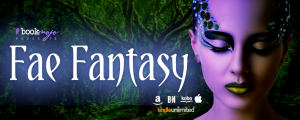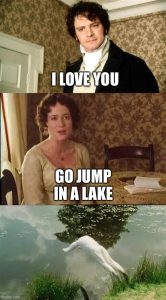As you may have noticed or guessed, I’m a big fan of romantic comedies, though mostly in movies. I’m a bit pickier in books because I like the way movies do romance and am less fond of the conventions of American romance novels. I tend to prefer what was called “chick lit” back in the day, which is more like rom-com movies than like romance novels, and I like the British rom-com books, which are more chick lit/women’s fiction.
As for whether or not I like a rom-com, book or movie, I have a very simple test: Is it funny, and is it romantic?
Comedy is a fairly personal thing. What’s funny to one person may not be funny to another, and that’s why comedy is so hard and why just about every designated “romantic comedy” line Harlequin tried to start failed. If you promote something as funny and the audience doesn’t find it amusing, the audience sees it as a failure, even if they otherwise enjoyed it. I personally am not fond of humiliation humor, where most of the humor comes from the characters having bad things happen to them — the slipping on the banana peel sort of thing. A character who bumps into things a lot is not funny to me, unless there’s something else going on. I’m also not fond of the related category, what I think of as idiot humor — situations that arise out of a character doing things that anyone with two functioning brain cells would know not to do. One of the main reason I turn off a Christmas rom-com within the first ten minutes is the now-standard scene of the city girl arriving in the small town/rural area and doing a lot of falling down because she’s teetering around on stiletto heels in snow and ice. They have ice and snow in cities, too, and even city people would know that walking on ice in stiletto heels is a bad idea. Maybe someone who’s always lived in LA seeing snow for the first time wouldn’t know better, but I’ve generally found that people going to northern places for the first time are more likely to go overboard with the cold-weather gear. That would be the person who shows up in newly-purchased snow boots while the locals are in sneakers or even flip-flops (because it isn’t “real” snow until it’s up to your knees).
But where romantic comedy stories are more likely to fail for me is in the romance part. I break that down into a couple of tests.
1) Is there any reason why these people might actually like each other, aside from physical attractiveness?
Screenwriting guru Michael Hauge calls this “I love you because we’re in this movie together.” This tends to happen when the writers are so focused on the conflict keeping the couple apart until the happy ending that they forget to establish why they would even want to overcome that conflict. It’s like the story brainstorming is all about how much this couple thrown together in a wacky situation hates each other or how much the couple has to overcome to be together, and they totally forget the part about why they would want to be together. What do they see in each other? Do they have anything in common? What will they talk about and do after they get together? Can you imagine this relationship lasting?
Sometimes there’s outright animosity, where they’re jerks to each other. That’s my problem with the movie Leap Year. It almost squeaks by on an outstanding cast and pretty scenery, but I’m still baffled that this screenplay ever sold because on paper these are horrible, idiotic people who are terrible to each other, sometimes for no good reason, and often in ways that actually hurt themselves. They’re instantly at odds because the script says they have to be (plus a lot of idiot and humiliation humor). The actors manage to sell them falling for each other, but we never really know why they’re falling in love. We don’t know what they have in common, what they would talk about, what they want out of life. They mostly fall in love because they’re the main characters in a rom-com who look like Matthew Goode and Amy Adams.
Not to keep harping on Four Weddings and a Funeral, but the only thing that keeps the main romance there going is the fact that she’s alluring and elusive. For most of the movie he can’t have her (though he kind of does, anyway) because she’s getting married to someone else. Her taste seems to be very different from his. What would they talk about? What would they do outside the bedroom? Would she be that appealing to him if he saw her all the time and there was nothing stopping him from being with her?
Or most of the couples in Love Actually. Aside from the movie stand-ins, who have real conversations and get to know each other, it’s actually a plot point for most of them that they haven’t actually ever talked to each other. Some of them go to extremes to be able to be with this other person they’ve never really talked to and know almost nothing about.
Now I’m trying to think of favorite movies that actually pass this test, and it’s hard. The best I can generally come up with is movies in which the characters seem to get each other, they encourage each other, and make each other laugh. I guess it’s hard to show common interests or what they’d talk about when they’re not in the wacky situation that gives them conflict. I might not like the ending, but I guess Notting Hill works here, where we see their conversations while she’s hiding out at his place, and it’s like getting a glimpse into what their life together might be like. The couple in While You Were Sleeping is mostly having “getting to know you” conversations, but they support each other’s dreams. She urges him to take his furniture-making business full-time and he gives her the snowglobe of Florence to encourage her to finally take that trip and get a stamp in her passport.
As much as I love When Harry Met Sally, I have to admit that I have a hard time imagining that relationship working. It’s mostly about them being total opposites. They’re hanging out because they run into each other again at a time when they’re both at loose ends after ending relationships and they can commiserate. Most of their conversations are about their past relationships and their dating woes. I don’t know what they’d talk about after they’re married, but they do at least make each other laugh and enjoy spending time together.
2) Do I actually want them to end up together?
This one is as personal as what a person considers funny. Sometimes I can see that there’s a reason for the couple to fall in love, and yet I’m still not sure they’re good for each other. That’s where I am on Notting Hill. I can see why they fall for each other, but I’m not sure I like them together, especially given the way the story is resolved. The relationship is too unbalanced and that’s never fixed. I’m not all that sure why he’s into her other than the fact that she’s a beautiful, wealthy movie star. If a more “ordinary” woman treated him the way she does I’m not sure he’d be interested, even if she made him laugh and they both enjoyed secret gardens. And if she weren’t a movie star who enjoys feeling “normal,” would she be into him? But I guess since this is the situation, it does seem to work. I’m just not totally happy with the resolution.
Bridget Jones’s Diary is a lot of fun (both book and movie), but I’m not super keen on the relationship. Bridget and Mark end up together because it’s a rewrite of Pride and Prejudice and that couple ended up together, but Bridget is no Lizzie. She’s kind of an idiot. She’s rather shallow and uninformed, in spite of working in news (not entirely unrealistic — I had to explain the issues around a situation to a TV reporter when I was a college student intern at a TV station) while he’s very keen on global affairs. There’s something a little patronizing about his attraction to her, kind of an “aren’t you adorable, bless your little heart” attitude. Not that I blame him, but I don’t imagine a lot of success for a relationship that’s essentially got a parent/child (or pet owner/goofball cat) dynamic.
One movie that worked out romantically exactly the way I wanted it to was Miss Pettigrew Lives for a Day. The couple in While You Were Sleeping seems good (though I’d have preferred them not to jump so quickly to marriage).
I need to give my collection another look to see what other films pass my test. There are plenty that are “almosts” but that I still enjoy for other reasons. I think this may be why I’m not super keen on plain romance. If that’s all that’s going on in a book or movie, odds are that I won’t want the couple to get together or don’t like the relationship, and then there’s nothing for me to like. At least in a good comedy I can find it amusing, even if I don’t like the romance part. In a fantasy, mystery, or other crossover there’s a plot and setting that I like, aside from the relationship. In women’s fiction or chick lit, there’s usually some kind of community-building and/or a “get your act together” plot, with the relationship being secondary. In general, I prefer romance as a seasoning/side dish rather than as the main part of the main course.


 Meanwhile, Darcy has realized he’s in love with her, but his first effort at proposing is a total failure because he tries to do so without giving up any of his power. Yes, there’s the vulnerability of admitting he admires and loves her and wants to marry her, but he wraps it up in power displays by pointing out how unsuitable she is, how awful her family is, how she really has nothing going on for her. So, he may like her, but she’s lucky he does so because there’s not a lot there to like.
Meanwhile, Darcy has realized he’s in love with her, but his first effort at proposing is a total failure because he tries to do so without giving up any of his power. Yes, there’s the vulnerability of admitting he admires and loves her and wants to marry her, but he wraps it up in power displays by pointing out how unsuitable she is, how awful her family is, how she really has nothing going on for her. So, he may like her, but she’s lucky he does so because there’s not a lot there to like.